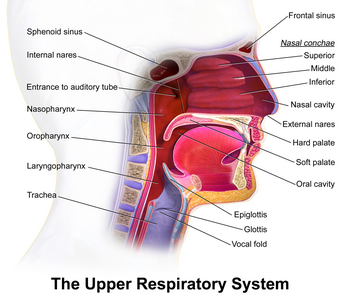Medicine:Stertor
From HandWiki
| Stertor | |
|---|---|
 | |
| Stertor caused by partial obstruction of the upper airways, at the level of the nasopharynx or oropharynx.[1] |
Stertor, from Latin 'stertere' to snore, and first used in 1804,[2] is a noisy breathing sound like snoring.[3][4] It is caused by partial obstruction of the upper airways, at the level of the nasopharynx or oropharynx.[1]
It is distinguished from stridor by its pitch.[4] Stertor is low-pitched, and can occur when breathing in, out or both.[5] Stertor and stridor can occur together, such as when adenotonsillar hypertrophy and laryngomalacia occur together.[5]
References
- ↑ 1.0 1.1 Innes, J. Alastair, ed (2018). Macleod's Clinical Examination (14th ed.). Edinburgh London New York: Elsevier. pp. 186. ISBN 978-0-7020-6993-2.
- ↑ "Definition of STERTOR" (in en). https://www.merriam-webster.com/dictionary/stertor.
- ↑ O Cathain E, Gaffey MM. Upper Airway Obstruction. In: StatPearls. StatPearls Publishing, Treasure Island (FL); 2020.
- ↑ 4.0 4.1 Englar, Ryane E. (3 July 2019). "Stertor and Stridor" (in en). Common Clinical Presentations in Dogs and Cats (John Wiley & Sons, Ltd): 449–461. doi:10.1002/9781119414612.ch34. ISBN 9781119414582. https://onlinelibrary.wiley.com/doi/abs/10.1002/9781119414612.ch34. Retrieved 9 January 2021.
- ↑ 5.0 5.1 Ida, Jonathan; Thomson, Dana Mara (2014). "Paediatric stridor". in Bower, Charles M. (in en). Common ENT Disorders in Children, An Issue of Otolaryngologic Clinics of North America, E-Book. Elsevier. pp. 798. ISBN 978-0-323-32622-3. https://books.google.com/books?id=6jkHBgAAQBAJ&pg=PA798-799.

